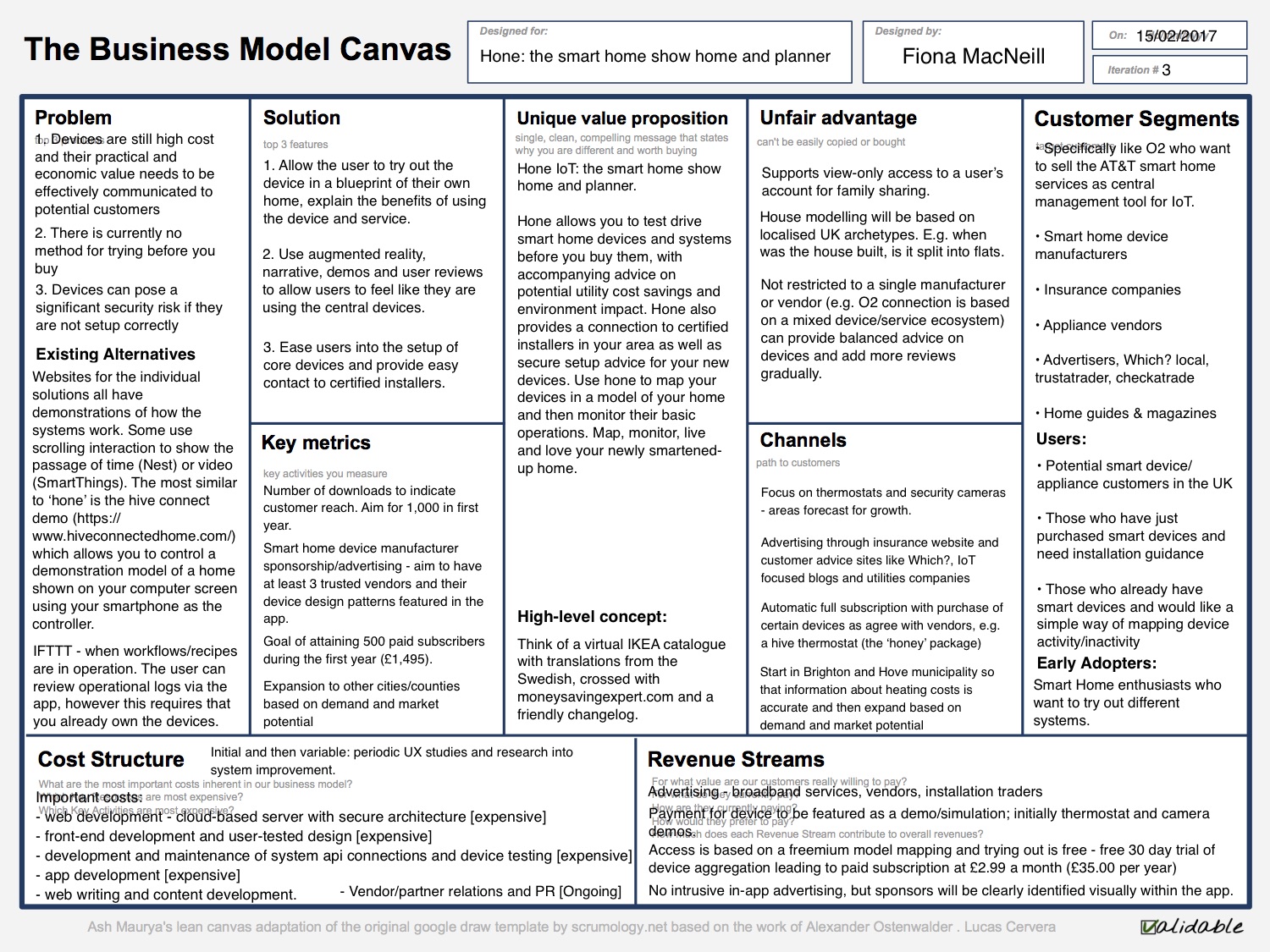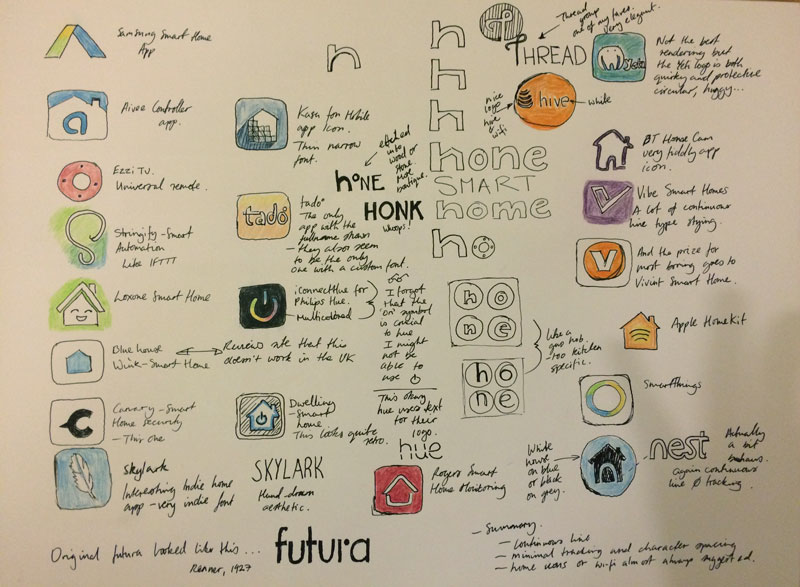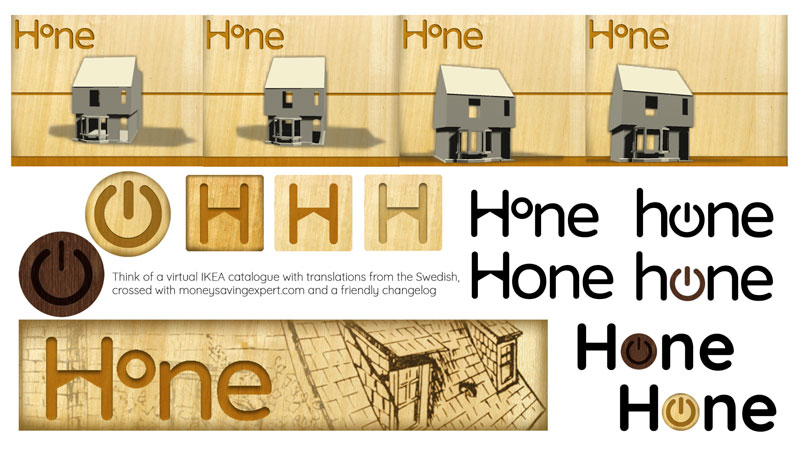Rationale
This is my second journal entry of the week and provides a brief explanation of how my thinking has shifted slightly since my initial Lean Business Canvases.
Now at version 3, you can view the newly revised Lean Canvas below.

Lean Business Model Canvas (http://www.businessmodelcanvas.com), licensed under Creative Commons Attribution-Share Alike 3.0 Unported licenses (http://creativecommons.org/licenses/by-sa/3.0).
I used this version as opposed to Richard’s template as the PDF layout of this version has some more space in some key areas such as customer segments, however I have addressed the same points as
the version that we used in class.
Here is a quick list of ways that my thinking has changed:
- My customers manufacture, install or promote IoT. Initially I thought that my main customers would be those who own IoT/smart home devices.
- My users do not own IoT, but they are interested in it. I realised that targeting those people who did not yet own IoT devices made a more compelling business idea than something that sated the 3% of the population who do already own these smart thermostats for example (Carroll, 2016b).
- The emphasis changed from being a monitoring app to being a try before you buy app, it is essentially a model/show smart home. The monitoring is still part of the product, but the trying out functions more important (the monitoring will likely be out of scope for the initial prototype).
- As the app presents a level of service, connecting potential customers to vendors and installers, it is will be more relevant if it localised. I am working on the principle that the app could start being Brighton specific and then expand later on (Brighton & Hove City Council, 2016; Zoopla, n.d.).
- One of the strengths of being Brighton specific is that the app can be based on local housing information and common floor plans.
- Also based on the reticence of the smart home market in the UK as compared to US (Carroll, 2016a; Carroll, 2016b; Titcomb, 2016); 3.7% in US in 2015 vs. 0.7% in the UK (Statista, 2015c) it seems that an app that explains the merits of such technologies will be helpful.
- I looked at what was available already and several independent app developers (e.g. PubNub, 2017; Skylark, 2015; Stringify, 2016) and broadband/data providers (e.g. AT&T Digital Life (2017) and O2 ) are vying for the one-app-to-rule them all area. They are a lot further along in this goal than a new start-up would be. Also with Thread group (2017) certified products, based on a specific mesh network setup and encryption, coming out this year as reported on the IoT podcast (Higginbotham, 2017); this may cause disruption for independent developers.
- Nest and Hive Thermostats have some good literature on their sites about energy efficiency, although the benefits are mentioned not made explicit. It struck me that explaining the potential savings of a Smart Thermostat (both from heating economy and environmental perspectives) might be a compelling feature.

Sketching some of the apps which come up in the Apple App Store based on a search for “Smart Home”. Based on observation, all of these apps are based on prior ownership of devices and then the apps can be used as controllers.

Another contact sheet of logo trials. I did some informal sentiment checking with these via social media and re-worked the most popular ones as familial groups. Logos 1-3 were popular amongst Europeans and Americans. Younger americans preferred the non-enclosed On/Power button icon (24-30yrs), whereas older Americans and Europeans like the enclosed On/Power button.
Logo 19 was an off-beat addition, but introduced an element with the “o” directly pointing to the heating connection and the home icon in the negative space. This was enthusiastically received by some viewers. The H as house with the negative space also received some positive views. This is completely anecdotal and not impartial (due to my presence in the discussion thread)
at this point and some more thorough testing will need to take place.

Having looked at the other apps that are available, which are very remote-control-like in their design, I felt that this app should run counter to that. Also, the presentation of the devices themselves on vendor websites can be quite sterile, often shown in pristine homes at the fore-font of interior design.
This makes it hard for the user to see themselves using the device. I also noticed that some of the images showing the devices suggested human presence (e.g. some children’s toys in view) but were quite barren otherwise. This got me thinking, what if IKEA sold smart homes (well there are some rumblings that this might happen)?
IKEA sell often quite sterile minimalist furniture and appliances, but it all about the experience of the perusing, the trying and then the buying.
Based on my observation of the IKEA website (IKEA, 2017), IKEA get it right for the following reasons:
- IKEA uses stories about how people live and use things
- IKEA uses people to show how things are used and these people are normal and quirky. They remind us of us.
- IKEA uses the viewpoint of someone who is roughly 5ft, 6in in all their photos. This makes the viewer feel like they are part of the action.
- IKEA understand geography and their geographic identity as a company with close ties to a perceived national Swedish identity
I’ll have a think about whether I can include any of these aspects in my designs. This consideration of IKEA’s approach inspired me to come up with the following concept for the app:
Think of a virtual IKEA catalogue [for smart homes] with translations from the Swedish, crossed with moneysavingexpert.com and a friendly changelog
References
AT&T. (2016, January 5). O2 to offer AT&T digital life platform and tado° to UK consumers in 2016 [Press release]. Retrieved from http://about.att.com/story/o2_to_offer_att_digital_life.html
AT&T. (2017). AT&T Digital Life. Retrieved from https://www.att.com/digital-life/
Brighton and Hove County Council. (2016, March 24). City plan part one. Retrieved from the Brigton and Hove City Council website: http://www.brighton-hove.gov.uk/content/planning/planning-policy/city-plan-part-one
Carroll, M. (2016a, May 30). Berg Insight reveals European smart home penetration lags North America [Blog post]. Retrieved from http://www.fiercewireless.com/europe/berg-insight-reveals-european-smart-home-penetration-lags-north-america
Carroll, M. (2016b, August 29). Report: Deloitte reveals stagnation in UK smart home market [Blog post]. Retrieved from http://www.fiercewireless.com/europe/report-deloitte-reveals-stagnation-uk-smart-home-market
Higginbotham, S. (2017, February 16). Episode 99: Tim Cook’s HomeKit setup and Echo mania [Podcast]. Retrieved from http://iotpodcast.com/2017/02/episode-99-tim-cooks-homekit-setup-and-echo-mania/
IKEA. (2017). IKEA furniture and home furnishings. Retrieved from http://www.ikea.com/gb/en/
PubNub. (2017). Remote device control for IoT. Retrieved from https://www.pubnub.com/solutions/remote-control/
Ransome, L. (n.d.). Burglar alarms and home security Home CCTV. Which?. Retrieved from http://www.which.co.uk/reviews/burglar-alarms-and-home-security/article/burglar-alarms-and-home-security/home-cctv
Skylark. (2015). Skylark for Nest & Honeywell Smart Thermostats (Version 3.1.2) [Mobile application software]. Retrieved from https://itunes.apple.com/gb/app/skylark-for-nest-honeywell/id815947897?mt=8
Statista. (2015a). Household penetration rate of smart homes in the United Kingdom (UK) from 2015 to 2021, by segment. Retrieved from https://www.statista.com/statistics/528103/smart-home-penetration-uk-digital-market-outlook-by-segment/
Statista. (2015b). Number of active households in the smart home market in the United Kingdom (UK) from 2015 to 2021 (in millions). Retrieved from https://www.statista.com/statistics/477134/smart-home-households-digital-market-outlook-uk/
Statista. (2015c). Smart home household penetration rate in selected countries worldwide in 2015. Retrieved from https://www.statista.com/statistics/483757/global-comparison-smart-home-household-penetration-digital-market-outlook/
Statista. (2015d). Top connected technologies that homeowners think they will be likely to purchase in the near future in the United Kingdom (UK) in 2015. Retrieved from https://www.statista.com/statistics/672135/top-connected-technologies-homeowner-consider-buying-in-near-future-in-the-uk/
Stringify. (2016). Stringify (Version 1.4.6) [Mobile application software]. Retrieved from https://itunes.apple.com/gb/app/stringify/id1012539039?mt=8
Thread group. (2017). Connected home. Retrieved from http://threadgroup.org/What-is-Thread/Connected-Home
Titcomb, J. (2016, August 27). Internet of things struggles as use of smart home gadgets flatlines. The Telegraph.. Retrieved from http://www.telegraph.co.uk/technology/2016/08/27/internet-of-things-struggles-as-use-of-smart-home-gadgets-flatli/
Zoopla. (n.d.). Property for sale in BN1. Retrieved from http://www.zoopla.co.uk/for-sale/map/property/2-bedrooms/bn1/?q=BN1&radius=0&search_source=refine